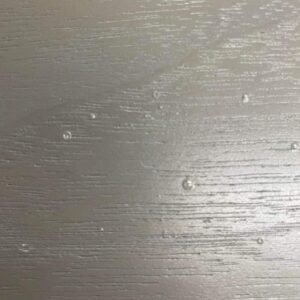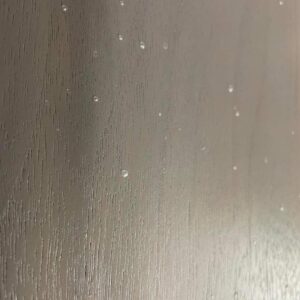Hello!
Looking for help diagnosing the cause of some air bubbles that are appearing in a lacquer finish.
Details:
-This only ever occurs on veneered plywood. White oak, walnut, alder, maple etc.
-One side of the panel will have no bubbles, the other side will. Size, location and frequency vary. Sometimes only one, sometimes 20+.
-They can occur over a stain or just as a clear coat.
-Spray pattern is consistent
-They only ever occur on the first coat
-It’s not consistent. I can go whole projects without having an issue only
for it to pop back up later.
Pictures are a stained Walnut panel.
Any thoughts are appreciated, I’ll answer any questions as timely as I can!
















Replies
Normally I would blame such problems on the gun not atomizing properly, but you say it only happens on plywood and then only on the initial coat. This leads me to think that there is some type of off-gassing going on with the plywood probably adhesive related. You don't mention what type of lacquer you are using, but lacquer solvents can be very reactive and it's possible it may be having some effect on the plywood adhesive in places where the veneer is thin or the wood a bit more porous.
Have you tried an initial sealer coat? Maybe shellac? A retarder added to your initial coat might buy enough time for the gas bubbles to dissipate as well, just be careful of drips and runs.
Thanks so much.
We’re using a pre-catalyzed product, (Coverdale is the manufacturer).
We typically don’t use a sealer, but I’ll give that a try.
You should be able to test my theory. Take a scrap of plywood maybe 2' x 2' and sand it heavily to the point of almost sanding through the veneer and then do one side with the sealer one without to see if it has an impact.
If you do decide to use a sealer like shellac and since you sound like a pro I would suggest you remake your sample boards you show to customers because shellac will likely change the tone of the finish adding some warmth.
What are your thoughts on using a propane torch to quickly skim the finish after applied to relieve or pop the trapped air pockets.
This is a fundamental step when using epoxy -to relieve trapped air.
Reference Stone Coat and Counter Top Epoxy for better clarification.
Obviously air is being trapped and needs to be relieved.
When working with epoxy on a router edge it is very important to work the edge and elevate the trapped air
If he didn't turn into the human torch from an open flame around lacquer fumes, unlike epoxy which can be softened by heat lacquer would just dry quicker.
Indeed. "Give a man a fire and you keep him warm for a day; set a man on fire and you keep him warm for the rest of his life." Terry Pratchett.
Open flame and lacquer DO NOT MIX.
I know this thread is from quite a while back, but I'm hoping it might still be active. Were you able to figure out what the issue was with the bubbling on the veneer? I am having a similar problem on Maple cabinet doors with a rotary cut center panel we sell unfinished to one particular customer. After the stain, when the sealer is applied of the front of the door we can immediately see the bubbles form and off gas on the veneer portion only--they do not go away and become hard. When the back of the door is done with the same procedure the veneer is perfectly fine--no bubbles or off gasing. The customer thinks the veneer is defective and wants new doors. My issue with this is none of my other customers are having these issues on the products we supply. Also, when the customer finished the lot of doors we provided, the veneer center panels were from different production lots, but all reacted in the same way. I really want find what the cause is and recommend an equitable solution.
In my experience this is caused when the paint booth temperature is higher than the storage space temperature. Air is expanding in the wood pores due to the equalization of temperatures of the wood. At the same time the lacquer film is skinning over and bubbles form. Solution may be to add a retarder to the finish, or make sure the item being sprayed has been acclimated to the paint booth temperature.
“[Deleted]”
I also wouldn’t count out contamination if water borne finish. I suffered small bubbles from my laying a roll of Frog tape on the center panel as I taped off the edges. Yep, small bubbles on panel after panel. Contamination may be from diesel truck exhaust or shop heater, tools, or not fully dried stain in the rotary veneer that may have accepted more stain than the solid wood or ? All are a reach, but could be the culprit.
The tech support of the finish manufacturer could be your friend in trouble shooting as well as the plywood manufacturer.
Best in troubleshooting.
What JerryC2023 said is correct!
This forum post is now archived. Commenting has been disabled